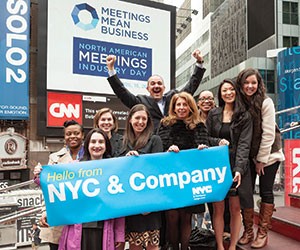Meetings Mean Business (MMB) and other industry leaders on April 16 brought together thousands for the first annual North American Meetings Industry Day (NAMID).
“NAMID 2015 brought together the entire meetings industry in a new and meaningful way,” says Nan Marchand Beauvois, the U.S. Travel Association vice president who oversees the MMB coalition. “By joining together with organizations across Canada, Mexico and Central America, we were able to demonstrate the real impact that meetings have on businesses, economies and communities. "The continent-wide day of advocacy showcased the industry’s strength and demonstrated the tremendous value of face-to-face meetings.”
According to Marchand Beauvois, with a total of 88 events spanning across North America, NAMID was a testament to the industry’s widespread passion, engagement and drive to spread its value message to a wider audience.
“We are grateful to everyone who stood up with the industry, especially the elected officials and leaders from Las Vegas, New York, Wisconsin, Washington, D.C., Toronto and Mexico who presented formal proclamations in support of the event,” Marchand Beauvois says.
“Today is not just about executing an event. It is about raising awareness of the power of meetings in shaping local communities; economically, environmentally, socially and intellectually,” adds Stuart Taylor, Canada Chapter business manager for MPI. “In 2012, meetings in Canada contributed $27.5 billion to our gross domestic product (GDP) - approximately 1.5 percent of Canada’s total GDP. But meetings don’t just propel the economy; when you gather people of similar interests from far and wide new solutions are found, new ideas innovated and even greater productivity discovered.”
NAMID’s Roots
MMB first emerged during the 2009 economic crisis when meetings cancellations and cutbacks were rampant. Until the past year or so, MMB has been more of a reactive effort, addressing media-led crises like “Muffingate” and disparaging remarks out of the White House about Las Vegas events.
Marchand Beauvois says there hasn’t been a sustained effort to put eyes and ears to meetings advocacy at all levels until recently. Increasing pressures on meetings such as government budget cuts and media-driven boycotts surrounding political debates about social issues have elevated the need for more robust advocacy efforts.
“Boycotts like the one we’ve seen around legislation in Arkansas and Indiana are effective,” Marchand Beauvois says, “but often come with unintended consequences to local communities who count on in-person meetings, events, conferences and conventions to sustain themselves. Part of our job is to raise the issue and remind those involved that local businesses are not the target of travel suspensions and meetings cancelations, but are often the ones to pay the price.”
More high-level spokespeople are also needed for industry advocacy, she adds.
“What we really need now are more high-profile advocates like Bill McDermott, CEO of SAP,” she contends.
McDermott, who is head of the world’s largest business software company, spoke at IMEX America last fall in Las Vegas. He explained how he set out to achieve 10 times more company growth partly by rethinking the company’s entire events strategy.
“During my time at Xerox, I’d learned that you have to bring people together; you can’t motivate for growth by using email!” McDermott told his Las Vegas audience.
Advocacy Going Forward
MMB organizers say they are now about building meetings industry advocacy on a sustained, ongoing basis, but there are significant challenges in doing so. Addressing budget pressures on government sector meetings and proving the value of face-to-face meetings beyond the economic are two advocacy issues in the fore.
Stuart Taylor, MPI chapter business manager for MPI’s Canadian chapters, says proving value beyond the economic remains an important but difficult struggle for the industry everywhere.
“We need to talk about the value of face meetings more than one day a year,” Taylor maintains, “and it remains a struggle to educate local communities to the broader business value of face meetings and how they contribute to the overall business success. Doing more to measure the impact of meetings after they happen is our challenge.”
Tech tools can help with the challenge, says Mariela McIlwraith, CMP, CMM, president of Toronto-based Meeting Change.
“We have economic impact numbers for face meetings, but that is just part of the equation,” McIlwraith says. “What happens when we come together is exciting and we need to be able to capture that part of the story.”
According to Marchand Beauvois, “There will undoubtedly be an NAMID 2016 that builds on the momentum and success of this first year.”



